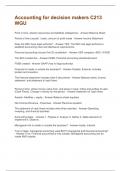Exam (elaborations)
Accounting for decision makers C213 WGU Questions with Answers (All Answers Correct)
- Course
- Institution
Point in time, Assets (resources) and liabilities (obligations) - Answer-Balance Sheet Period of time (usually 1 year), amount of profit made - Answer-Income Statement Does the SEC have legal authority? - Answer-YES. The SEC has legal authority to establish accounting rules and disclosure requir...
[Show more]



